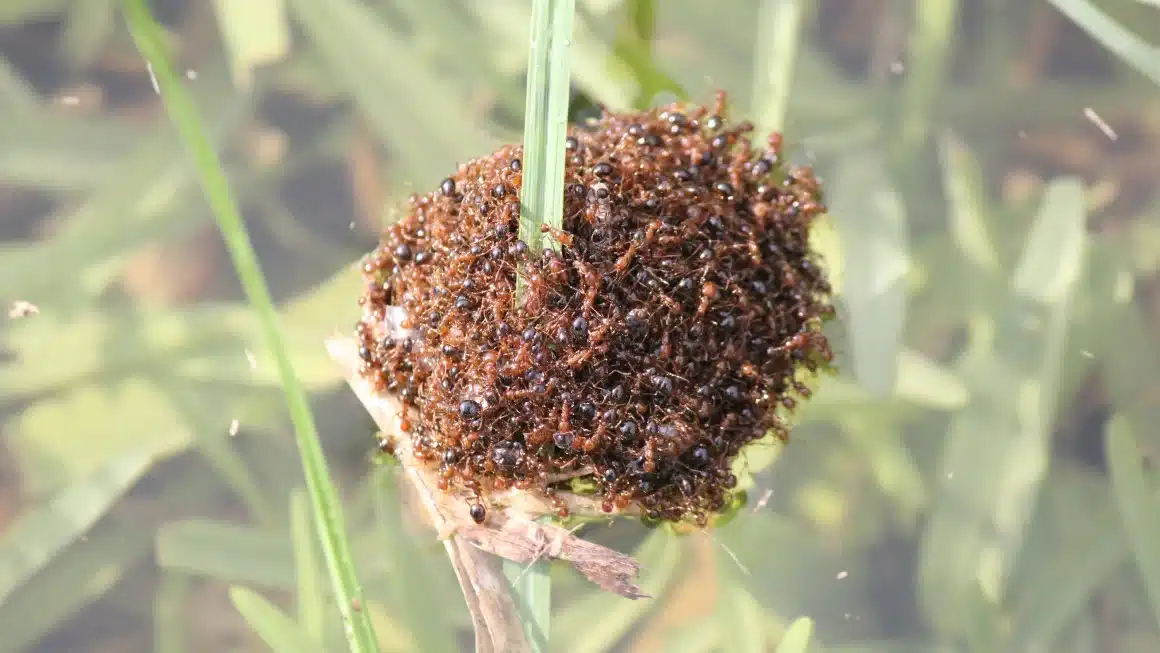Science
How Deadly Fire Ants Are Surviving Australian Floods: A Perilous Journey

Red fire ants are constructing rafts to travel on flood waters in Queensland, northeastern Australia, as extreme weather threatens the highly invasive species’ expansion across the country.
“The recent heavy rainfall and wild weather in the region could accelerate the spread of fire ants, one of the world’s worst invasive species,” Reece Pianta, advocacy manager at Australia’s Invasive Species Council (ISC), said in a statement Tuesday.
“Fire ants are more active before or after rain, and they can form large floating rafts that move with water currents to establish footholds in new areas,” Pianta said, advising locals to be vigilant. The ISC posted a video on social media showing fire ants migrating in raft formation.
“It’s incredibly simple to do your part. Just snap a picture of any unusual ants and report them,” he said.
How Deadly Fire Ants Are Surviving Australian Floods: A Perilous Journey
Queensland has experienced severe weather and flooding in recent weeks. Last month, the remnants of Tropical Cyclone Jasper poured severe rains to Cairns, cutting the city off. Flooding also stranded many of the more than 150,000 residents on their rooftops.
According to ISC modelling, fire ants will spread to “every corner of Australia” if the Queensland outbreak is uncontrolled.
The ISC stated that it just obtained a 70 million Australian dollar ($46 million) four-year commitment from Victoria to support the national fire ant eradication effort. Pianta believes eradication is still attainable.
Solenopsis invicta, a red imported fire ant native to South America, is an omnivorous species that damages crops and livestock. Its deadly sting causes pustules and allergic responses and can be fatal to humans. Over the past century, it has expanded over the United States, Mexico, the Caribbean, China, and Australia. It made its maiden appearance in Europe last year.
How Deadly Fire Ants Are Surviving Australian Floods: A Perilous Journey
Australia’s first fire ant outbreak occurred in 2001, according to the ISC. According to the statement, the country has brought seven infestations under control, stretching from Queensland’s capital, Brisbane, to the border with the neighbouring state of New South Wales (NSW), to first contain and then eradicate the infestations.
However, in November 2023, the ants were discovered in New South Wales, raising concerns that they could spread to the Murray-Darling river basin and out of control.
At the time, Tara Moriarty, the Minister for Agriculture in New South Wales, stated that “red imported fire ant are a terrible invasive pest, which cause serious social, economic, and environmental harm.”
How Deadly Fire Ants Are Surviving Australian Floods: A Perilous Journey
“Our teams are focused on limiting further spread, and encouraging reporting and compliance through a targeted communications campaign,” she said.
Red ants can spread swiftly, but human activities, such as cargo containers or shipments of potted plants or soil, usually exacerbate an infestation.
SOURCE – (CNN)
Science
A Spacecraft Is On Its Way To A Harmless Asteroid Slammed By NASA In A Previous Save-The-Earth Test

CAPE CANAVERAL, Florida – A spacecraft launched Monday to probe the site of a cosmic accident.
The European Space Agency’s Hera spacecraft launched on a two-year trip to the little, harmless asteroid slammed by NASA two years ago as a practice run for the day when a murderous space rock threatens Earth. It’s the second phase of a planetary defense experiment that could one day save the globe.
SpaceX’s Falcon rocket vanished with Hera into the late morning clouds. An hour later, cheering erupted in the control center in Germany as the spacecraft split from the rocket’s upper stage and returned home. “It’s an amazing day,” the space agency’s director general, Josef Aschbacher, said later.
The 2022 crash of NASA’s Dart spacecraft reduced Dimorphos’ orbit around its larger companion, indicating that if a harmful rock was heading our way, it might be pushed off course with adequate warning.
nasa
A Spacecraft Is On Its Way To A Harmless Asteroid Slammed By NASA In A Previous Save-The-Earth Test
Scientists are eager to analyze the aftermath of the impact up close to determine how effective Dart was and what improvements may be required to protect Earth in the future.
“The more detail we can glean the better as it may be important for planning a future deflection mission should one be needed,” University of Maryland astronomer Derek Richardson stated before launch.
Researchers want to know if Dart (short for Double Asteroid Redirection Test) created a crater or changed the 500-foot (150-meter) asteroid more dramatically. It seemed to be a flying saucer before Dart’s blow and may now resemble a kidney bean, according to Richardson, who participated in the Dart mission and is assisting Hera.
Dart’s wallop sent rubble and boulders hurtling off Dimorphos, adding to the impact’s momentum. For months, the debris track extended thousands of miles (almost 10,000 kilometers) into space.
According to flight director Ignacio Tanco, some rocks and debris may still be hovering about the asteroid, posing a threat to Hera.
A Spacecraft Is On Its Way To A Harmless Asteroid Slammed By NASA In A Previous Save-The-Earth Test
“We don’t really know very well the environment in which we are going to operate,” Tanco informed me. “But that’s the whole point of the mission is to go there and find out.”
European authorities refer to the $400 million (363 million euros) effort as a “crash scene investigation.”
“Hera is going back to the crime scene and getting all the scientific and technical information,” said project manager Ian Carnelli.
Carrying a dozen science instruments, the compact car-sized Hera must swing past Mars in 2025 for a gravitational boost before landing at Dimorphos by the end of 2026. It’s a moonlet of Didymos, the Greek word for twin, a five-times larger asteroid that spins quickly. At that point, the asteroids will be 120 million miles (195 million kilometers) from Earth.
Hera will attempt to enter orbit around the rocky duo, progressively reducing flyby distances from 18 miles (30 kilometers) to a half-mile (1 kilometer). The spacecraft will examine the moonlet for at least six months to determine its mass, shape, composition, and orbit around Didymos.
Before the crash, Dimorphos circled its larger partner from three-quarters of a mile (1,189 meters) away. Scientists believe the orbit has become tighter and more oval-shaped, and that the moonlet may be tumbling.
Two shoebox-sized Cubesats will launch from Hera for even closer drone-like examinations, with one employing radar to peek beneath the moonlet’s boulder-strewn surface. Scientists believe Dimorphos was produced from particles shed by Didymos. The radar measurements should assist in determining whether Didymos is the small moon’s parent.
A Spacecraft Is On Its Way To A Harmless Asteroid Slammed By NASA In A Previous Save-The-Earth Test
After their survey, the CubeSats will attempt to land on the moonlet. If the moonlet tumbles, the situation will become more complicated. Hera may potentially conclude its mission with a perilous touchdown but on the bigger Didymos.
Asteroids, which are remnants of the solar system’s origin 4.6 billion years ago, circle the sun principally between Mars and Jupiter in what is known as the main asteroid belt, where millions of them live. When they fall from the belt and land in our area, they become near-Earth objects.
NASA now has around 36,000 near-Earth objects, the majority of which are asteroids, although there are also some comets. More than 2,400 of them are deemed potentially dangerous to the Earth.
SOURCE | AP
Science
A Rare Comet Brightens The Night Skies In October

NEW YORK — Prepare to spot a rare and dazzling comet.
The space rock is hurling toward Earth from the far reaches of the solar system and will make its closest approach on Saturday. It should be visible through the end of October, assuming clear skies.
A Rare Comet Brightens The Night Skies In October
Comet Tsuchinshan-Atlas should be visible to the naked eye, but binoculars and telescopes will provide a clearer view.
“It’ll be this fuzzy circle with a long tail stretching away from it,” explained Sally Brummel, planetarium manager at the Bell Museum in Minnesota.
What is a comet?
They are frozen remains from billions of years ago when the solar system was formed. They heat up as they swing toward the sun, revealing their distinctive streaming tails.
In 2023, a green one that had last visited Earth 50,000 years ago flew past again. Other significant flybys were Neowise in 2020 and Hale-Bopp and Hyakutake in the mid to late 1990s.
Where did Tsuchinshan-Atlas come from?
Also known as C/2023 A3, was found last year and named after the observatories in China and South Africa that spotted it.
It originated in the Oort Cloud, which extends far beyond Pluto. After making its closest approach to Earth at 44 million miles (71 million kilometers), it will not return for another 80,000 years, provided it survives the journey.
A Rare Comet Brightens The Night Skies In October
Every year, several comets are detected, but many of them burn up near the sun or are too far away to be observed without special equipment, according to Larry Denneau, a key researcher with the Atlas telescope that helped discover it.
How to View
Those seeking to see Tsuchinshan-Atlas should go outside about an hour after sunset on a clear night and look to the west.
The comet should be visible from both the Northern and Southern Hemispheres.
SOURCE | AP
Science
NASA Switches Off Instrument On Voyager 2 Spacecraft To Save Power

NEW YORK — To save power, NASA turned off another scientific equipment on its long-running Voyager 2 spacecraft.
NASA Switches Off Instrument On the Spacecraft To Save Power
The space agency announced on Tuesday that 2’s plasma science instrument, meant to study the movement of charged atoms, was turned off in late September to allow the spacecraft to continue exploring for as long as possible, which is estimated to be into the 2030s.
NASA turned off a suite of instruments on Voyager 2 and its twin, Voyager 1, after exploring the gas giant planets in the 1980s. Both are currently in interstellar space or the region between stars. The plasma instrument on Voyager 1 stopped working years ago and was finally shut off in 2007.
The remaining four instruments on 2 will continue to collect data on magnetic fields and particles. Its mission is to investigate the regions of space beyond the sun’s protective sphere.
NASA Switches Off Instrument On Voyager 2 Spacecraft To Save Power
It launched in 1977, is the only spacecraft to have visited Uranus and Neptune. It is now more than 12 billion miles (19.31 billion kilometers) from Earth. 1 is more than 15 billion miles (24.14 billion kilometers) beyond Earth.
SOURCE | AP
-
News3 weeks ago
The Biden Administration can go Ahead With Student Loan Forgiveness, Says a Federal Judge.
-
News3 weeks ago
Tesla Recalls 27,000 Cybertrucks Due To A Rearview Camera Issue
-
World3 weeks ago
Uber Hires Yandex Spinoff Ride-Hail and Autonomous Delivery With Avride
-
Tech3 weeks ago
Accenture and NVIDIA Collaborate to Enhance AI Implementation.
-
Tech3 weeks ago
Meta has started the Facebook Content Monetization Program.
-
Election News3 weeks ago
Chief Operating Officer Of Truth Social’s Parent Company Resigns











































